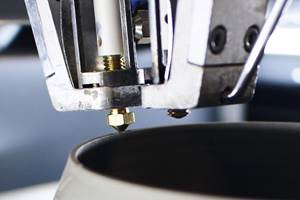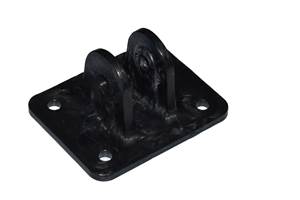Researchers successfully 3D print carbon fiber
Lawrence Livermore National Laboratory (LLNL) researchers claim to be the first to 3D print aerospace-grade carbon fiber.
Researchers from Lawrence Livermore National Laboratory (LLNL, Livermore, CA, US) believe they have made a significant advance in the development of micro-extrusion 3D printing techniques for carbon fiber. This research was published by the journal Scientific Reports online.
"The mantra is 'if you could make everything out of carbon fiber, you would' — it's potentially the ultimate material," says Jim Lewicki, principal investigator and the paper's lead author. "It's been waiting in the wings for years because it's so difficult to make in complex shapes. But with 3D printing, you could potentially make anything out of carbon fiber."
Carbon fiber composites are typically fabricated one of two ways — by physically winding the filaments around a mandrel, or weaving the fibers together like a wicker basket, resulting in finished products that are limited to either flat or cylindrical shapes, Lewicki says. Fabricators also tend to overcompensate with material due to performance concerns, making the parts heavier, costlier and more wasteful than necessary.
However, LLNL researchers reported printing several complex 3D structures through a modified Direct Ink Writing (DIW) 3D printing process. Lewicki and his team also developed and patented a new chemistry that can cure the material in seconds instead of hours, and used the lab's computing capabilities to develop accurate models of the flow of carbon fiber filaments.
"How we got past the clogging was through simulation," Lewicki says. "This has been successful in large part because of the computational models."
Computational modeling was performed on LLNL's supercomputers by a team of engineers who needed to simulate thousands of carbon fiber as they emerged from the ink nozzle to find out how to best align them during the process.
"We developed a numerical code to simulate a non-Newtonian liquid polymer resin with a dispersion of carbon fibers. With this code, we can simulate evolution of the fiber orientations in 3D under different printing conditions," says fluid analyst Yuliya Kanarska. "We were able to find the optimal fiber length and optimal performance, but it's still a work in progress. Ongoing efforts are related to achieving even better alignment of the fibers by applying magnetic forces to stabilize them."
The ability to 3D print offers new degrees of freedom for carbon fiber, researchers say, enabling them to have control over the parts' mesostructure. The material also is conductive, allowing for directed thermal channeling within a structure. The resultant material, the researchers say, could be used to make high-performance airplane wings, satellite components that are insulated on one side and don't need to be rotated in space, or wearables that can draw heat from the body but don't allow it in.
"A big breakthrough for this technology is the development of custom carbon fiber-filled inks with thermoset matrix materials," says materials and advanced manufacturing researcher Eric Duoss. "For example, epoxy and cyanate ester are carefully designed for our printing process, yet also provide enhanced mechanical and thermal performance compared to thermoplastic counterparts that are found in some commercially available carbon fiber 3D printing technologies, such as nylon and ABS (a common thermoplastic). This advance will enable a broad range of applications in aerospace, transportation and defense."
The direct ink writing process also makes it possible to print parts with all the carbon fibers going the same direction within the microstructures, allowing them to outperform similar materials created with other methods done with random alignment. Through this process, researchers said they're able to use two-thirds less carbon fiber and get the same material properties from the finished part.
The researchers will next turn to optimizing the process, figuring out the best places to lay down the carbon fiber to maximize performance. There have been discussions with commercial, aerospace and defense partners to move forward on future development of the technology.
Other lab researchers included on the paper are Jennifer Rodriguez, Cheng Zhu, Marcus Worsley, Amanda Wu, John Horn, Jason Ortega, William Elmer, Ryan Hensleigh, Ryan Fellini and Michael King.
This computer animation below simulates how carbon fibers align and extrude through a 3D printing nozzle.
Related Content
Plant tour: Spirit AeroSystems, Belfast, Northern Ireland, U.K.
Purpose-built facility employs resin transfer infusion (RTI) and assembly technology to manufacture today’s composite A220 wings, and prepares for future new programs and production ramp-ups.
Read MoreA new era for ceramic matrix composites
CMC is expanding, with new fiber production in Europe, faster processes and higher temperature materials enabling applications for industry, hypersonics and New Space.
Read MoreHybrid process marries continuous, discontinuous composites design
9T Labs and Purdue applied Additive Fusion Technology to engineer a performance- and cost-competitive aircraft bin pin bracket made from compression-molded continuous and discontinuous CFRTP.
Read MorePlant tour: Aernnova Composites, Toledo and Illescas, Spain
RTM and ATL/AFP high-rate production sites feature this composites and engineering leader’s continued push for excellence and innovation for future airframes.
Read MoreRead Next
VIDEO: High-volume processing for fiberglass components
Cannon Ergos, a company specializing in high-ton presses and equipment for composites fabrication and plastics processing, displayed automotive and industrial components at CAMX 2024.
Read MoreComposites end markets: New space (2025)
Composite materials — with their unmatched strength-to-weight ratio, durability in extreme environments and design versatility — are at the heart of innovations in satellites, propulsion systems and lunar exploration vehicles, propelling the space economy toward a $1.8 trillion future.
Read MoreAll-recycled, needle-punched nonwoven CFRP slashes carbon footprint of Formula 2 seat
Dallara and Tenowo collaborate to produce a race-ready Formula 2 seat using recycled carbon fiber, reducing CO2 emissions by 97.5% compared to virgin materials.
Read More


























